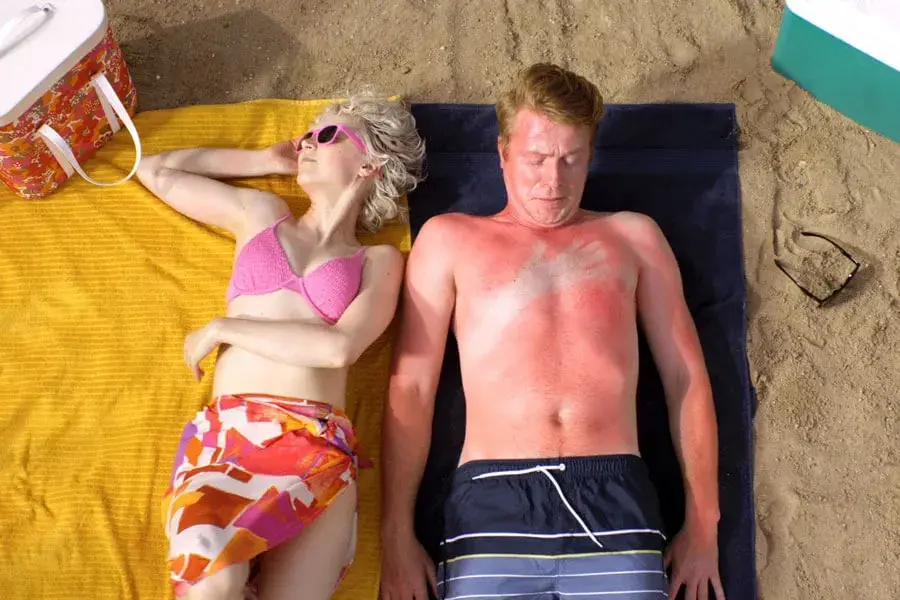What Is a Sunburn?
Sunburn is an inflammatory response to damage to the top-most layers of skin. This is most often caused by exposure to ultraviolet (UV) rays, which can come from the sun or artificial sources like tanning beds.1,2
It may seem like the damage is just on the surface, but unprotected exposure to UV rays over time can lead to premature skin aging—and in some cases—skin cancer. Even if you don’t necessarily burn, this exposure still damages skin cells and may lead to complications down the road.1
When outside, protecting yourself from the sun is the best way to avoid more serious burns. Severe sunburn can turn into more intense skin conditions, such as sun rash or “hell’s itch”—an extremely itchy sunburn. If you think you might have a sunburn, it’s important to know what type of sunburn it is so you can relieve and properly treat your skin. Read on to learn about why sunburns itch, symptoms associated with the different types of sunburns, as well as treatment options.
Why Do Sunburns Itch?
Researchers aren’t exactly sure why sunburns itch, but they have a few ideas. After a sunburn, the outer layer of skin is damaged, which may lead to a special type of inflammation known as neurogenic inflammation. During this process, immune cells flock to the damaged area, some releasing histamine. As a result, the skin becomes itchy and painful.3
Discover other causes of itchy skin here.
Types of Sunburns & Symptoms
Sunburns tend to fall into two categories: first-degree and second-degree burns. First-degree burns are damage to only the outer layers of skin, and typically heal over the course of three to seven days.2
First-degree burns are associated with mild sunburn symptoms, including:2
Redness
Blistering
Peeling skin
Skin that feels tight or hot
Pain or tenderness
You may also have a fever, feel fatigued or nauseous, or have a headache. This is because sunburn can draw fluid away from the body to the skin. Be sure to drink plenty of fluids after a day in the sun to help alleviate these symptoms.4
Second-degree sunburns involve damage to the inner layer of the skin, known as the dermis. Since these burns are deeper, they can take days to weeks to heal. In severe cases, medical treatment may be necessary.2
Symptoms of second-degree sunburns include:
Blistering and swelling over a large area of skin
Pain
Skin that is extremely red and/or appears wet
White discoloration within the burned area
It’s important to note that sunburn can occur to any exposed skin, even if it seems covered. Loosely woven fabrics can let UV rays through, burning the skin. You may have even heard that you can get sunburnt on cloudy days—and this is true! In fact, up to 80% of UV rays can still break through clouds, which may lead to a surprise sunburn.1
Sun Rash & Sun Poisoning
Cases of particularly bad sunburn can turn into sun poisoning. While they share similar symptoms, sun poisoning is not an allergic reaction. Instead, it is a severe sunburn that can progressively get worse over the course of a few hours.5
Symptoms of sun poisoning can feel similar to the flu or an allergic reaction, and include:
Blistering/peeling skin
Nausea
Dehydration
Confusion
Dizziness or lightheadedness
Shortness of breath
Fainting
Sun poisoning can also cause a severe skin rash to form known as a sun rash—or a polymorphic light eruption.6,7 This reaction can cause an itchy, burning red rash on the skin that typically forms on the chest, head, neck, and arms. You can also develop a sun rash on your face. For some people, sun rash can develop within 20 minutes of sun exposure. However, for most, it develops after hours of excessive sun exposure.7
What does a sun poisoning rash look like?7
Itchy, burning rash that appears within a few hours, or up to three days, after prolonged exposure to the sun
Small patches of raised red or pink spots, known as sun bumps
Blisters that turn into large, dry patches—similar to eczema
Patches that look like a bullseye (these are less common)
If you suspect you have sun poisoning or a sunburn rash, it is best to seek medical treatment. Oftentimes, dehydration develops alongside sun poisoning, so your doctor may give you intravenous (IV) fluids to help. If you notice the sunburnt areas begin bleeding or oozing, see your doctor immediately as these are signs of infection.5
What Is “Hell’s Itch” and Its Symptoms?
If your sunburn is peeling, that means it is healing. This can be an itchy, somewhat painful process—but in some rare cases, the itch can be taken to a whole new level. This is known as hell’s itch, or the devil’s itch, which can feel like a deep, painful, throbbing itch that lasts for a few days after sunburn.8
Hell’s itch is fairly rare, and it tends to affect people with fairer skin, and those who have been exposed to the sun at higher altitudes—such as being in the mountains. Doctors aren’t exactly sure why this condition happens, but they suspect that it’s due to damage to the nerve endings after a severe sunburn.8
Some symptoms of hell’s itch can be treated at home, but if you show these symptoms, it’s best to seek medical treatment:8
Chills
Dizziness or confusion
Blisters over large areas of the body
As much as you want to, it’s best to avoid scratching the itch, which can lead to more irritation.
Tips To Prevent Sunburn
If you plan on being outside for an extended period of time—especially on sunny days—be sure to take extra precautions to protect your skin. This not only helps prevent burns and short-term pain and itching but also lasting damage to your skin.
Around 20 to 30 minutes before going outside, apply sunscreen to help shield your skin from harmful UV rays. In fact, it is recommended to wear sunscreen every day on areas that regularly get sun exposure, like your face and ears. Reapplying it every two hours when outside can keep you protected, especially if you are sweating or swimming. Take note of the sun protection factor (SPF) of your sunscreen—an SPF of at least 30 is recommended for everyone. If you have had skin cancer or are at an increased risk for developing it, try using at least 45 SPF.9
Along with sunscreen, try to wear clothing made of tightly woven fabrics that cover the arms and legs. You should be able to hold the fabric up to the sun, and light does not pass through. Covering up your head with a wide-brimmed hat can also help prevent your face, ears, scalp, and neck from burning.9
To protect your eyes, look for sunglasses that provide 100% protection from UV rays. They should block both UV-A and UV-B rays, which can be damaging to your retinas. Never look directly into the sun either, even when wearing sunglasses.10
Sunburn Pain and Itch Relief
Most of the time, sunburns heal naturally on their own over the course of days to weeks. However, there are different at-home remedies and over-the-counter treatments available to provide sunburn relief and help manage the symptoms during this healing process.
Taking a cool shower or bath can help relieve pain from sunburn and cool your warm skin. After getting out, gently pat your skin dry with a clean towel, but leave a little water. Applying a moisturizer can help replenish the skin and trap water inside to ease dryness. Lotions and gels that contain soy or aloe vera are recommended.4
Over-the-counter pain relievers like ibuprofen or naproxen can also offer pain relief. While they are advertised for pain relief, it’s best to avoid applying products that end in “-caine” to the skin, as these can irritate it or cause an allergic reaction.11
BENADRYL® also offers several products which feature the active ingredient diphenhydramine HCl to help treat itchy skin from sunburn, among other uses and indications. Oral antihistamines—like BENADRYL® Allergy ULTRATABS®—and topical antihistamines like BENADRYL® Itch Stopping Gel and BENADRYL® Itch Stopping Cream can target itch at its source.
References
Skin Cancer Foundation. Sunburn & Your Skin. May 2021. Accessed from: https://www.skincancer.org/risk-factors/sunburn/
Cleveland Clinic. Sunburn. September 30, 2021. Accessed from: https://my.clevelandclinic.org/health/diseases/21858-sunburn
Journal of Travel Medicine. Hell’s itch could be caused by neurogenic inflammation: proposed pathophysiology and treatment options. January 2021. Accessed from: https://academic.oup.com/jtm/article/28/1/taaa204/5940800?login=true
American Academy of Dermatology Association. How To Treat Sunburn. Accessed from: https://www.aad.org/public/everyday-care/injured-skin/burns/treat-sunburn
Cleveland Clinic Health Essentials. What You Should Know About Sun Poisoning Symptoms. March 15, 2022. Accessed from: https://health.clevelandclinic.org/do-you-have-sun-poisoning-4-less-known-facts/
Mayo Clinic. Sun rash: Causes and prevention. October 20, 2020.
National Health Service. Polymorphic light eruption. July 28, 2021. Accessed from: https://www.nhs.uk/conditions/polymorphic-light-eruption/
Cleveland Clinic Health Essentials. What the Heck Is Hell’s Itch? March 18, 2022. Accessed from: https://health.clevelandclinic.org/what-the-heck-is-hells-itch/
Cleveland Clinic. Sun Damage: Protecting Yourself. October 10, 2019. Accessed from: https://my.clevelandclinic.org/health/articles/5240-sun-damage-protecting-yourself
American Academy of Ophthalmology. The Sun, UV Light and Your Eyes. June 11, 2020. Accessed from: https://www.aao.org/eye-health/tips-prevention/sun
Mayo Clinic. Sunburn. July 17, 2020. Accessed from: https://www.mayoclinic.org/diseases-conditions/sunburn/diagnosis-treatment/drc-20355928


